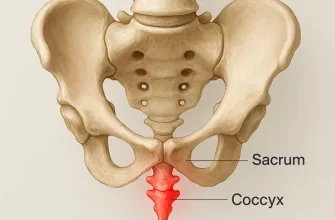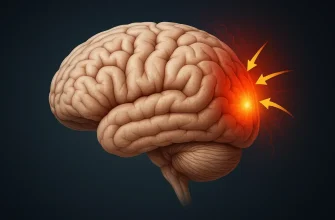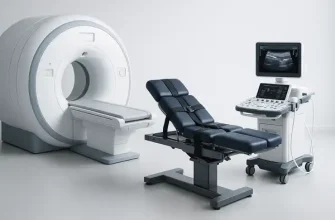Middle back pain, particularly severe spinal pain, is a condition that affects many people globally, but often lacks the same attention as lower back pain. It can be debilitating, impacting daily activities and quality of life. This article explores the various causes of severe middle back pain, the latest trends in diagnosis and treatment, and practical steps to find relief.
What is Middle Back Pain?
Middle back pain refers to pain or discomfort that occurs in the thoracic spine—the section of the spine that starts at the base of the neck and extends to the bottom of the rib cage. The thoracic spine is less prone to injury compared to the lumbar region, yet it plays an essential role in stability and protecting vital organs.
Prevalence and Statistics
Middle back pain is less common than lower back pain, accounting for about 10-15% of all reported back pain cases. A study published in the Journal of Pain Research found that around 20% of individuals aged 40 and above have experienced middle back pain, with women slightly more prone to the condition compared to men. Additionally, sedentary lifestyles, poor posture, and specific occupational hazards (e.g., desk jobs or lifting heavy objects) have contributed to an increasing number of middle back pain complaints.
Causes of Severe Middle Back Pain
| Cause | Description | Percentage of Cases (Estimated) |
|---|---|---|
| Muscle Strain | Overuse or injury of muscles in the middle back | 35% |
| Herniated Discs | Spinal discs bulging, putting pressure on nerves | 20% |
| Osteoarthritis | Wear and tear of joints causing inflammation and pain | 15% |
| Poor Posture | Extended periods of slouching or improper sitting habits | 10% |
| Scoliosis or Deformity | Abnormal curvature of the spine | 8% |
| Trauma or Injury | Injuries from accidents, falls, or sports activities | 7% |
| Other | Infections, tumors, or other spinal conditions | 5% |
Muscle strain is the leading cause of middle back pain, often resulting from activities that involve heavy lifting or repetitive motion. Improper posture, particularly from extended hours at a desk or in front of a computer, is also a significant contributor.
Symptoms and When to Seek Medical Help
Middle back pain symptoms can range from a dull, persistent ache to sharp, severe pain. Common symptoms include:
- Stiffness or Tightness: Reduced mobility or a feeling of tightness in the thoracic region.
- Sharp or Radiating Pain: Severe pain that may radiate around the rib cage or into the chest.
- Muscle Spasms: Sudden, involuntary contractions of the back muscles.
It is crucial to seek medical help if you experience severe pain that does not improve with rest, pain that radiates to the chest or abdomen, or any neurological symptoms like numbness or weakness. These may be signs of a more serious underlying condition requiring prompt attention.
Diagnostic Techniques and Costs
Diagnosis of severe middle back pain typically involves a physical examination, followed by imaging techniques if necessary. Below is a summary of common diagnostic tools and their estimated costs:
| Diagnostic Tool | Average Cost (USD) |
|---|---|
| X-ray | $150 – $300 |
| MRI | $1,000 – $3,500 |
| CT Scan | $500 – $1,500 |
MRI is often recommended when a herniated disc or nerve compression is suspected, as it provides detailed images of both bone and soft tissues. Although more expensive, an MRI can offer the best insights into the causes of middle back pain.
Treatment Options
Treatment for severe middle back pain varies based on the underlying cause. Here is a breakdown of common treatments:
- Physical Therapy: One of the most recommended non-invasive treatments. It involves exercises to strengthen back muscles and improve posture. Physical therapy sessions range from $50 to $150 per session, depending on location and therapist qualifications.
- Medications: Over-the-counter pain relievers, like ibuprofen, can help reduce inflammation. For more severe pain, muscle relaxants or even prescription opioids may be prescribed (though opioids are generally discouraged due to their addictive nature).
- Chiropractic Care: Chiropractic adjustments can help alleviate pain caused by misalignment. An average session costs between $50 and $100.
- Heat and Ice Therapy: Alternating heat and ice packs can reduce muscle tension and inflammation.
- Surgery: In rare cases, surgery may be required to correct structural issues like herniated discs. The cost of spinal surgery can vary significantly, ranging from $20,000 to $100,000.
Effectiveness of Treatments for Severe Middle Back Pain
Practical Example: Treating Middle Back Pain
A 45-year-old office worker with severe middle back pain due to poor posture and muscle strain may benefit significantly from physical therapy combined with posture correction. After three months of therapy, including exercises aimed at strengthening the thoracic region, patients often report a significant reduction in pain levels.
For example, a study involving 50 participants with middle back pain showed that 70% experienced reduced pain after 12 weeks of targeted physical therapy, with additional benefits noted in mobility and overall well-being.
Modern Trends in Managing Middle Back Pain
One of the most notable trends is the increased use of wearable posture correctors. These devices are designed to promote better posture throughout the day, which can prevent the recurrence of middle back pain. Prices for wearable posture correctors range from $20 to $80. Moreover, remote physical therapy and guided exercise programs have become more accessible, allowing people to seek treatment from the comfort of their homes.
Another rising trend is the use of mind-body techniques, such as progressive muscle relaxation and deep breathing exercises. While these methods do not directly treat the spine, they help in managing the pain perception and reducing the emotional toll of chronic pain.
Advice from Our Editorial Team
Severe middle back pain can be managed effectively with a combination of lifestyle changes, targeted therapies, and awareness. Addressing poor posture, staying active, and seeking timely medical advice are the cornerstones of managing this condition. Consider working with a physical therapist to develop a custom exercise routine that strengthens the thoracic region. Prevention plays a vital role—incorporating regular stretching, taking frequent breaks from sitting, and using ergonomic furniture can make a big difference in keeping your spine healthy.









